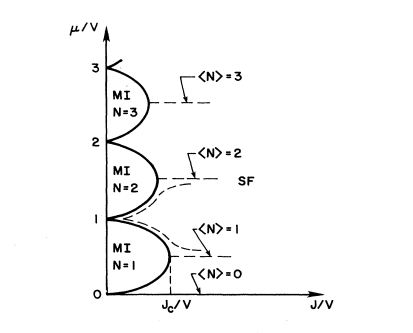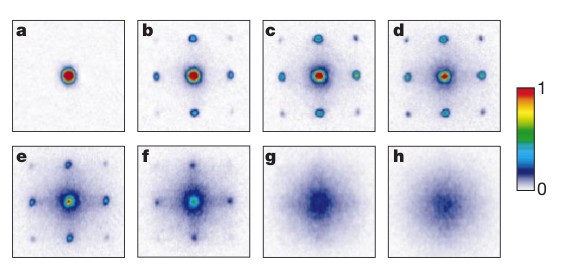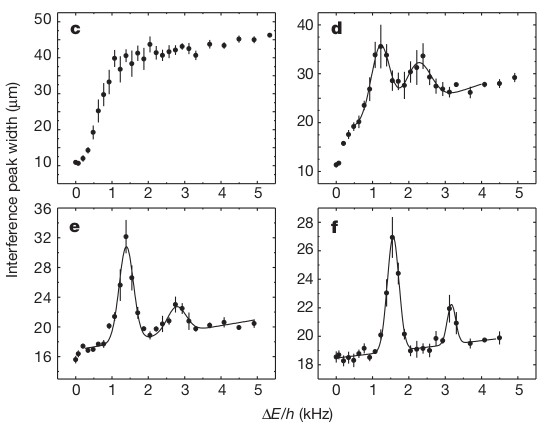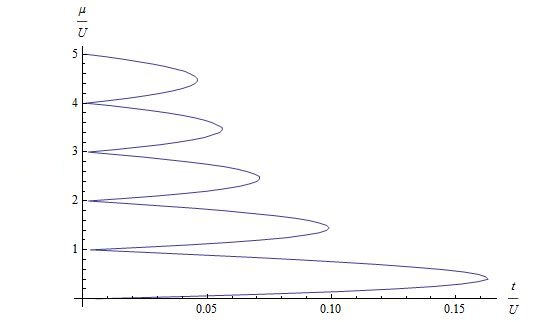Bose Hubbard model
Introduction
The Bose-Hubbard Model (BHM) was first studied in theoretical detail in 1989 by Fisher et al.[1]

It was discovered that at zero temperature if the bosons are in a lattice they can be in one of two phases. The phase diagram in figure 1 shows this explicitly: there is the superfluid phase and the Mott insulator phase. The phase the system is in depends on the strength of the hopping interaction(J in the figure 1, 4t in our analysis) as well as the chemical potential Failed to parse (SVG (MathML can be enabled via browser plugin): Invalid response ("Math extension cannot connect to Restbase.") from server "https://wikimedia.org/api/rest_v1/":): {\displaystyle \mu} (which sets the particle number) and the on site repulsion (V in figure 1, U in our analysis).
The Bose Hubbard Hamiltonian
The Bose Hubbard model Hamiltonian, on an Failed to parse (SVG (MathML can be enabled via browser plugin): Invalid response ("Math extension cannot connect to Restbase.") from server "https://wikimedia.org/api/rest_v1/":): {\displaystyle N\times N} 2 dimensional grid, is given by the expression
Failed to parse (SVG (MathML can be enabled via browser plugin): Invalid response ("Math extension cannot connect to Restbase.") from server "https://wikimedia.org/api/rest_v1/":): {\displaystyle \begin{array}{c} \mathcal{H}= -t \sum _{i=1}^N \sum _{j=1}^N \left(b_{i,j}^{\dagger }b_{i+1,j}+b_{i,j}^{\dagger }b_{i,j+1}+b_{i+1,j}^{\dagger }b_{i,j}+b_{i,j+1}^{\dagger }b_{i,j}\right) \\ +\frac{U}{2}\sum _{i=1}^N \sum _{j=1}^N b_{i,j}^{\dagger }b_{i,j}\left(b_{i,j}^{\dagger }b_{i,j}-1\right)-\mu \sum _{i=1}^N \sum _{j=1}^N b_{i,j}^{\dagger } b_{i,j} \end{array} }
Here the creation and annihilation operators obey Bose commutation relations Failed to parse (SVG (MathML can be enabled via browser plugin): Invalid response ("Math extension cannot connect to Restbase.") from server "https://wikimedia.org/api/rest_v1/":): {\displaystyle \left[b_i,b_j{}^{\dagger }\right]=\delta _{i,j}} . The spinless bosons can represent Cooper pairs of electrons undergoing Josephson tunneling between superconducting islands[2], or atoms in an optical lettice.
Mean Field Theory Solution For The Ground State
Single Site Hamiltonian
The single site Hamiltonian for interacting bosons is:
Failed to parse (SVG (MathML can be enabled via browser plugin): Invalid response ("Math extension cannot connect to Restbase.") from server "https://wikimedia.org/api/rest_v1/":): {\displaystyle \mathcal{H}_{\text{site}}= \frac{U}{2}b^{\dagger }b \left(b^{\dagger }b-\mathbf{1}\right)- \mu b^{\dagger }b\text{ }+ \left(\psi^{*}b +b^{\dagger }\psi\right)}
Where Failed to parse (SVG (MathML can be enabled via browser plugin): Invalid response ("Math extension cannot connect to Restbase.") from server "https://wikimedia.org/api/rest_v1/":): {\displaystyle U > 0, \mu \geq 0} and Failed to parse (SVG (MathML can be enabled via browser plugin): Invalid response ("Math extension cannot connect to Restbase.") from server "https://wikimedia.org/api/rest_v1/":): {\displaystyle \psi} , Failed to parse (SVG (MathML can be enabled via browser plugin): Invalid response ("Math extension cannot connect to Restbase.") from server "https://wikimedia.org/api/rest_v1/":): {\displaystyle \psi^{*}} are c-numbers.
Here, the field Failed to parse (SVG (MathML can be enabled via browser plugin): Invalid response ("Math extension cannot connect to Restbase.") from server "https://wikimedia.org/api/rest_v1/":): {\displaystyle \psi} is meant to stand for the average of the influence of all neighboring sites.
Solution For Failed to parse (SVG (MathML can be enabled via browser plugin): Invalid response ("Math extension cannot connect to Restbase.") from server "https://wikimedia.org/api/rest_v1/":): {\displaystyle \psi = \psi^{*}=0}
In this case the Hamiltonian can be rewritten as:
Failed to parse (SVG (MathML can be enabled via browser plugin): Invalid response ("Math extension cannot connect to Restbase.") from server "https://wikimedia.org/api/rest_v1/":): {\displaystyle \mathcal{H}_{\text{site}}= \frac{U}{2}b^{\dagger }b \left(b^{\dagger }b-\mathbf{1}\right)- \mu b^{\dagger }b = \frac{U}{2}b^{\dagger }b\text{ }\left(b^{\dagger }b - \left(1+2 \frac{\mu }{U}\right)\mathbf{1} \right)} .
Unnormalized eigenstates of this Hamiltonian areFailed to parse (SVG (MathML can be enabled via browser plugin): Invalid response ("Math extension cannot connect to Restbase.") from server "https://wikimedia.org/api/rest_v1/":): {\displaystyle |n\rangle}
.
Failed to parse (SVG (MathML can be enabled via browser plugin): Invalid response ("Math extension cannot connect to Restbase.") from server "https://wikimedia.org/api/rest_v1/":): {\displaystyle \mathcal{H}_{\text{site}}|n\rangle = \frac{U}{2}b^{\dagger }b\text{ }\left(b^{\dagger }b |n\rangle - \left(1+2 \frac{\mu }{U}\right)|n\rangle \right)= \frac{U}{2}\text{ }\left(n^2- \left(1+2 \frac{\mu }{U}\right)n\right)|n\rangle}
The normalized eigenstate is Failed to parse (SVG (MathML can be enabled via browser plugin): Invalid response ("Math extension cannot connect to Restbase.") from server "https://wikimedia.org/api/rest_v1/":): {\displaystyle \frac{1}{\sqrt{n!}}|n\rangle} with eigenenergy Failed to parse (SVG (MathML can be enabled via browser plugin): Invalid response ("Math extension cannot connect to Restbase.") from server "https://wikimedia.org/api/rest_v1/":): {\displaystyle E_n =\frac{U}{2}\text{ }\left(n^2- \left(1+2 \frac{\mu }{U}\right)n\right)}
The ground state of which is unique for the ratio Failed to parse (SVG (MathML can be enabled via browser plugin): Invalid response ("Math extension cannot connect to Restbase.") from server "https://wikimedia.org/api/rest_v1/":): {\displaystyle \frac{\mu}{U} \notin \mathbb{Z}} ; it is equal to Failed to parse (SVG (MathML can be enabled via browser plugin): Invalid response ("Math extension cannot connect to Restbase.") from server "https://wikimedia.org/api/rest_v1/":): {\displaystyle \left\lceil \frac{\mu }{U}\right\rceil} , the closest integer larger than Failed to parse (SVG (MathML can be enabled via browser plugin): Invalid response ("Math extension cannot connect to Restbase.") from server "https://wikimedia.org/api/rest_v1/":): {\displaystyle \frac{\mu }{U}} . On the other hand, we have a two-fold degeneracy for Failed to parse (SVG (MathML can be enabled via browser plugin): Invalid response ("Math extension cannot connect to Restbase.") from server "https://wikimedia.org/api/rest_v1/":): {\displaystyle \frac{\mu}{U} \in \mathbb{Z}} .
Solution For Failed to parse (SVG (MathML can be enabled via browser plugin): Invalid response ("Math extension cannot connect to Restbase.") from server "https://wikimedia.org/api/rest_v1/":): {\displaystyle \psi \neq 0} and Failed to parse (SVG (MathML can be enabled via browser plugin): Invalid response ("Math extension cannot connect to Restbase.") from server "https://wikimedia.org/api/rest_v1/":): {\displaystyle \psi \in \mathbb{R}}
Now that Failed to parse (SVG (MathML can be enabled via browser plugin): Invalid response ("Math extension cannot connect to Restbase.") from server "https://wikimedia.org/api/rest_v1/":): {\displaystyle \psi } is included lets redefine our states to be Failed to parse (SVG (MathML can be enabled via browser plugin): Invalid response ("Math extension cannot connect to Restbase.") from server "https://wikimedia.org/api/rest_v1/":): {\displaystyle |j\rangle = \frac{1}{\sqrt{j!}}b^{\dagger j}|0\rangle} . The Hamiltonian is now:
Failed to parse (SVG (MathML can be enabled via browser plugin): Invalid response ("Math extension cannot connect to Restbase.") from server "https://wikimedia.org/api/rest_v1/":): {\displaystyle \mathcal{H}_{\text{site}}= \frac{U}{2}b^{\dagger }b \left(b^{\dagger }b-\mathbf{1}\right)- \mu b^{\dagger }b\text{ }+\psi \left(b +b^{\dagger }\right)} .
Acting on Failed to parse (SVG (MathML can be enabled via browser plugin): Invalid response ("Math extension cannot connect to Restbase.") from server "https://wikimedia.org/api/rest_v1/":): {\displaystyle \mathcal{H}_{\text{site}}} with some general state Failed to parse (SVG (MathML can be enabled via browser plugin): Invalid response ("Math extension cannot connect to Restbase.") from server "https://wikimedia.org/api/rest_v1/":): {\displaystyle |\phi \rangle =\sum _{j=0}^n c_j|j\rangle} , we have:
Failed to parse (SVG (MathML can be enabled via browser plugin): Invalid response ("Math extension cannot connect to Restbase.") from server "https://wikimedia.org/api/rest_v1/":): {\displaystyle \left\langle i\left|\mathcal{H}_{\text{site}}-E \right|\phi \right\rangle =0}
Failed to parse (SVG (MathML can be enabled via browser plugin): Invalid response ("Math extension cannot connect to Restbase.") from server "https://wikimedia.org/api/rest_v1/":): {\displaystyle \Longrightarrow \sum _{j=0}^n c_j\left\langle i\left|\frac{U}{2}b^{\dagger }b \left(b^{\dagger }b-\mathbf{1}\right)- \mu b^{\dagger }b\text{ }+\psi \left(b +b^{\dagger }\right)-E \mathbf{1} \right|j\right\rangle = 0}
Failed to parse (SVG (MathML can be enabled via browser plugin): Invalid response ("Math extension cannot connect to Restbase.") from server "https://wikimedia.org/api/rest_v1/":): {\displaystyle \Longrightarrow \sum _{j=0}^n c_j\langle i|\left\{\frac{U}{2}j (j-1) |j\rangle - \mu j\text{ }|j\rangle \text{ }-E\text{ }|j\rangle +\psi \left(\sqrt{j} |j-1\rangle +\sqrt{j+1}|j+1\rangle \right)\right\}=0}
Failed to parse (SVG (MathML can be enabled via browser plugin): Invalid response ("Math extension cannot connect to Restbase.") from server "https://wikimedia.org/api/rest_v1/":): {\displaystyle \Longrightarrow \sum _{j=0}^n c_j\left\{\delta _{i ,j}\left[\frac{U}{2}j (j-1) - \mu j\text{ }-E\right]+\delta _{i ,j-1} \left[\psi \sqrt{j}\text{ }\right]+\delta _{i,j+1\text{ }}\left[\psi \sqrt{j+1}\right]\text{ }\right\}=0}
For Failed to parse (SVG (MathML can be enabled via browser plugin): Invalid response ("Math extension cannot connect to Restbase.") from server "https://wikimedia.org/api/rest_v1/":): {\displaystyle i=0} we have
Failed to parse (SVG (MathML can be enabled via browser plugin): Invalid response ("Math extension cannot connect to Restbase.") from server "https://wikimedia.org/api/rest_v1/":): {\displaystyle -c_0\frac{E}{U}+ c_1 \frac{\psi }{U}\text{ }= 0} .
For Failed to parse (SVG (MathML can be enabled via browser plugin): Invalid response ("Math extension cannot connect to Restbase.") from server "https://wikimedia.org/api/rest_v1/":): {\displaystyle i=n} we have
Failed to parse (SVG (MathML can be enabled via browser plugin): Invalid response ("Math extension cannot connect to Restbase.") from server "https://wikimedia.org/api/rest_v1/":): {\displaystyle c_n\overbrace{\left[\frac{1}{2}n (n-1) - \frac{\mu }{U} n -\frac{E}{U}\right]}^{\equiv D(n)}+c_{n-1}\left[\frac{\psi }{U}\sqrt{n}\right]\text{ }=0}
Defining a function Failed to parse (SVG (MathML can be enabled via browser plugin): Invalid response ("Math extension cannot connect to Restbase.") from server "https://wikimedia.org/api/rest_v1/":): {\displaystyle D[i] = \frac{1}{2}i (i-1) - \frac{\mu }{U} i -\frac{E}{U}} , we can write the above in matrix form:
Failed to parse (SVG (MathML can be enabled via browser plugin): Invalid response ("Math extension cannot connect to Restbase.") from server "https://wikimedia.org/api/rest_v1/":): {\displaystyle \left( \begin{array}{cccccccc} D(0) & \frac{\psi }{U} & 0 & 0 & 0 & \cdots & \cdots & 0 \\ \frac{\psi }{U} & D(1) & \frac{\psi }{U} \sqrt{1+1} & 0 & 0 & \cdots & \cdots & 0 \\ 0 & \frac{\psi }{U} \sqrt{2} & D(2) & \frac{\psi }{U} \sqrt{2+1} & 0 & \cdots & \cdots & 0 \\ 0 & 0 & \frac{\psi }{U} \sqrt{3} & D(3) & \frac{\psi }{U} \sqrt{3+1} & \cdots & \cdots & 0 \\ 0 & 0 & 0 & \frac{\psi }{U} \sqrt{4} & D(4) & \ddots & & \\ \vdots & \vdots & \vdots & \vdots & \vdots & \ddots & \ddots & \\ \vdots & \vdots & \vdots & \vdots & \vdots & \ddots & \ddots & \ddots \\ 0 & 0 & 0 & 0 & 0 & & \frac{\psi }{U}\sqrt{n} & D(n) \end{array} \right)\left( \begin{array}{c} c_0 \\ c_1 \\ c_2 \\ c_3 \\ c_4 \\ c_5 \\ \vdots \\ c_n \end{array} \right)=0}
Multi-Site Square Lattice Hamiltonian
By adding and subtracting the mean-field terms from all sites in the original Bose-Hubbard Hamiltonian, we can write:
Failed to parse (SVG (MathML can be enabled via browser plugin): Invalid response ("Math extension cannot connect to Restbase.") from server "https://wikimedia.org/api/rest_v1/":): {\displaystyle \mathcal{H} =\text{ }- t \sum _{i=1}^N \sum _{j=1}^N \left(b_{i,j}^{\dagger }b_{i+1,j}+b_{i,j}^{\dagger }b_{i,j+1} + b_{i+1,j}^{\dagger }b_{i,j}+b_{i,j+1}^{\dagger }b_{i,j} +\frac{\psi }{t}\left(b_{i,j} +b_{i,j}^{\dagger }\right)\right)+ \sum _{i=1}^N \sum _{j=1}^N b_{i,j}^{\dagger }b_{i,j}\left(\frac{U}{2}b_{i,j}^{\dagger }b_{i,j}-\frac{U}{2} - \mu \right)+\psi \sum _{i=1}^N \sum _{j=1}^N \left(b_{i,j} +b_{i,j}^{\dagger }\right)}
Failed to parse (SVG (MathML can be enabled via browser plugin): Invalid response ("Math extension cannot connect to Restbase.") from server "https://wikimedia.org/api/rest_v1/":): {\displaystyle =\overbrace{- t \sum _{i=1}^N \sum _{j=1}^N \left(b_{i,j}^{\dagger }b_{i+1,j}+b_{i,j}^{\dagger }b_{i,j+1} + b_{i+1,j}^{\dagger }b_{i,j}+b_{i,j+1}^{\dagger }b_{i,j} +\frac{\psi }{t}\left(b_{i,j} +b_{i,j}^{\dagger }\right)\right)}^{\equiv \overset{1}{\mathcal{H}}}+ \overbrace{\sum _{i=1}^N \sum _{j=1}^N \mathcal{H}_{i,j}(\psi ,\mu ,U)}^{\equiv \overset{2}{\mathcal{H}}}}
We will look at the second part first. Here Failed to parse (SVG (MathML can be enabled via browser plugin): Invalid response ("Math extension cannot connect to Restbase.") from server "https://wikimedia.org/api/rest_v1/":): {\displaystyle \overset{2}{\mathcal{H}}} is just a sum over the single-site mean field Hamiltonians that we considered. Therefore,
Failed to parse (SVG (MathML can be enabled via browser plugin): Invalid response ("Math extension cannot connect to Restbase.") from server "https://wikimedia.org/api/rest_v1/":): {\displaystyle \left\langle \Phi _{\text{trial}}\left|\overset{2}{\mathcal{H}}\right|\Phi _{\text{trial}}\right\rangle = \sum _{i=1}^N \sum _{j=1}^N E_{i,j}^{\text{ground}}(\psi ,\mu ,U) = N^2 E^{\text{ground}}(\psi ,\mu ,U)}
where Failed to parse (SVG (MathML can be enabled via browser plugin): Invalid response ("Math extension cannot connect to Restbase.") from server "https://wikimedia.org/api/rest_v1/":): {\displaystyle E^{\text{ground}}(\psi ,\mu ,U)} is the ground state eigenenergy from the single site case.
Looking now at the first term of the multi-site Hamiltonian we define a trial state as:
Failed to parse (SVG (MathML can be enabled via browser plugin): Invalid response ("Math extension cannot connect to Restbase.") from server "https://wikimedia.org/api/rest_v1/":): {\displaystyle \left|\Phi _{\text{trial}}\right\rangle = \overset{\otimes }{\underset{i,j}{\Pi }}\phi (i,j) = \overset{\otimes }{\underset{i,j}{\Pi }}\sum _{m=0}^n c_m(i,j) |m\rangle _{i,j}}
where Failed to parse (SVG (MathML can be enabled via browser plugin): Invalid response ("Math extension cannot connect to Restbase.") from server "https://wikimedia.org/api/rest_v1/":): {\displaystyle |m\rangle _{i,j}} denotes Failed to parse (SVG (MathML can be enabled via browser plugin): Invalid response ("Math extension cannot connect to Restbase.") from server "https://wikimedia.org/api/rest_v1/":): {\displaystyle m} bosons at lattice site Failed to parse (SVG (MathML can be enabled via browser plugin): Invalid response ("Math extension cannot connect to Restbase.") from server "https://wikimedia.org/api/rest_v1/":): {\displaystyle (i,j)} .
Failed to parse (SVG (MathML can be enabled via browser plugin): Invalid response ("Math extension cannot connect to Restbase.") from server "https://wikimedia.org/api/rest_v1/":): {\displaystyle \left.\left.\overset{1}{\mathcal{H}}\right|\Phi _{\text{trial}}\right\rangle =- t \sum _{i=1}^N \sum _{j=1}^N \left\{\text{ }b_{i,j}^{\dagger }b_{i+1,j}+b_{i,j}^{\dagger }b_{i,j+1} + b_{i+1,j}^{\dagger }b_{i,j}+b_{i,j+1}^{\dagger }b_{i,j} +\frac{\psi }{t}\left(b_{i,j} +b_{i,j}^{\dagger }\right)\text{ }\right\}\overset{\otimes }{\underset{k,l}{\Pi }}\sum _{m=0}^n c_m(k,l) |m\rangle _{k,l}}
Phase Transition
Experimental Evidence - Failed to parse (SVG (MathML can be enabled via browser plugin): Invalid response ("Math extension cannot connect to Restbase.") from server "https://wikimedia.org/api/rest_v1/":): {\displaystyle ^{87}Rb} Bose-Einstein Condensate[3]
Experimental Setup

The first experimental evidence in support of the BHM was observed in 2002.[3]
Greiner and collaborators created a Failed to parse (SVG (MathML can be enabled via browser plugin): Invalid response ("Math extension cannot connect to Restbase.") from server "https://wikimedia.org/api/rest_v1/":): {\displaystyle ^{87}Rb} Bose-Einstein condensate that was spherically symmetric, and magnetically trapped. To form the three dimensional lattice potential three optical standing waves were set up perpendicular to eachother with the crossing point of the three beams positioned at the center of the condensate. The magnetically trapped condensate was then transferred to the optical lattice by slowly increasing the beam intensity. By increasing slowly it was ensured that the atoms stayed in the many body ground state. When the beams reached full intensity the condensate was spread over more than 150,000 lattice sites with an average of 2.5 atoms per lattice cite in the center of the condenstate
Adjusting the potential depth via frequency variations allowed for Greiner et al. to essentially set the phase of the condensate. When they would set a potential, they would then turn it off. The atomic wavefunctions then expand freely and interfere with eachother. This allowed for a test of phase coherence of the system via diffraction patterns.
The phase was also tested by measuring the excitation spectrum of the condensate, as the superfluid state and the Mott insulator state should have markedly different spectrum's. In the Mott insulator phase the atoms are well localized in the lattice. An excitation occurs when a particle hole pair is created. For example if we had exactly one particle per lattice site, then an excitation would be when one particle tunnels to an adjacent site, creating a site with no particles and a site with two. To realize this excitation in the lab the lattice potential is tilted by the application of a potential gradient. This creates an energy difference between neighboring lattice sites that allows for the tunneling to an excited state. It was expected to see resonant excitations in the plot of intereference peak width versus energy difference in neighboring lattice sites.

Superfluid Phase
For the superfluid phase it was expected to observe sharp diffraction patterns. This is due to the fact that in the superfluid phase all atoms are delocalized, with equal relative phases between different lattice sites. Therefore the sharp diffraction patterns represent extreme phase coherence in the system.
In the excitation spectrum it was expected to not see resonant structure for the superfluid phase. It can be seen in figure 5 that this is the case. In box c, which corresponds to the superfluid lattice depth, there is no structure in the excitation spectrum
Mott Insulator Phase
For the Mott insulator phase it was expected to have a blurred diffraction pattern. This is because the system should lose all phase coherence which will result in no observable diffraction pattern. It can be observed in figure 4 that there is a clear loss of sharp diffraction patterns in box g, this corresponds to the onset of the Mott insulator phase.
In contrast to the superfluid phase, the Mott insulator phase should display resonant features in the excitation spectrum. We can see from figure 5 that the emergence of this behavior begins in plot d. As the lattice potential depth is increased, and it transitions past the critical point where the phase transition occurs, the resonance structure becomes more clearly defined.

